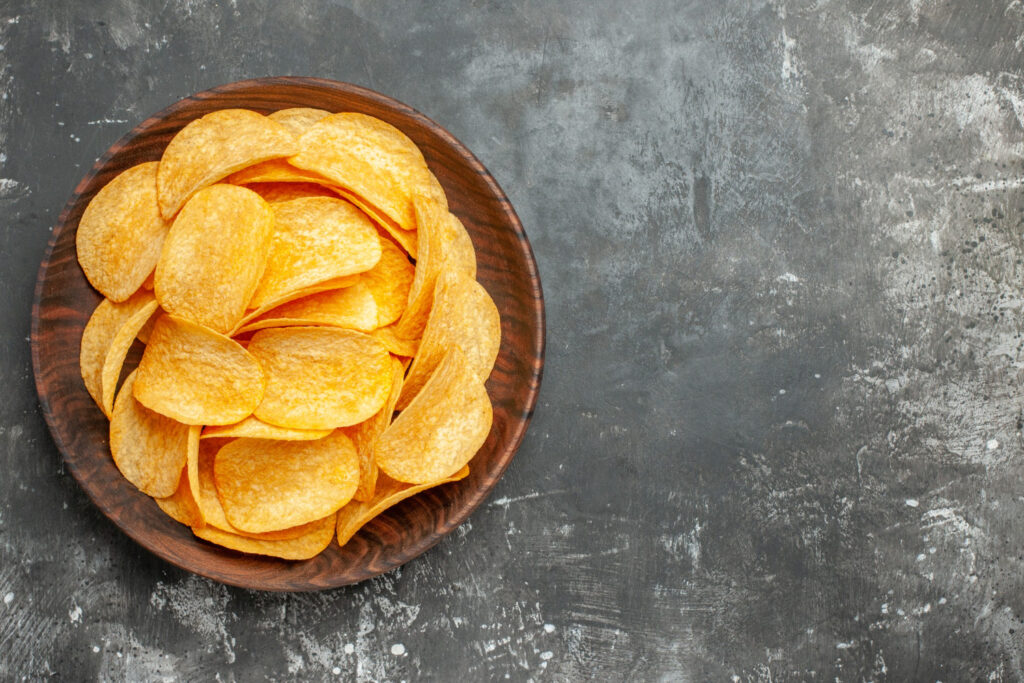Introduction: Understanding Chips Addiction
What is Chips Addiction?
Chips addiction is a compelling craving or dependence on consuming potato chips or similar snack foods. This addiction isn’t just about liking the taste; it involves a psychological and sometimes physical need to eat chips frequently. The combination of salt, fat, and crunch makes chips particularly irresistible and can lead to overeating and health issues.
Why Chips are So Addictive
The addictive nature of chips stems from their ingredients and how they interact with our brain. The saltiness enhances flavor, the fat provides a satisfying texture, and the crunch is highly pleasing to our senses. This trifecta triggers the release of dopamine, a neurotransmitter associated with pleasure and reward, making us want more.
1. Identifying the Signs of Chips Addiction
Physical Signs
Physical signs of chips addiction can include cravings for chips at specific times of the day, eating chips despite feeling full, and experiencing withdrawal symptoms like irritability when you don’t have chips. Over time, this can lead to weight gain and other health issues.
Emotional and Psychological Signs
Emotionally, chips addiction can manifest as using chips to cope with stress, boredom, or sadness. Psychologically, you might find yourself thinking about chips often or feeling guilty after eating them. Recognizing these signs is the first step towards overcoming the addiction.
2. The Health Impacts of Chips Addiction
Short-Term Effects
In the short term, chips addiction can lead to overeating, digestive discomfort, and poor nutrition. Chips are typically high in calories, salt, and unhealthy fats, which can contribute to bloating, dehydration, and a lack of essential nutrients.
Long-Term Health Risks
Long-term effects include an increased risk of obesity, heart disease, high blood pressure, and diabetes. The high sodium content in chips can lead to hypertension, while the unhealthy fats can contribute to cholesterol buildup and cardiovascular problems.
3. Understanding the Triggers
Emotional Triggers
Emotional triggers like stress, anxiety, and depression can drive you to reach for a bag of chips. These feelings often create a desire for comfort foods, and chips are an easy, quick fix that temporarily soothes negative emotions.
Environmental Triggers
Environmental factors such as having chips readily available at home, seeing advertisements, or social situations where chips are served can also trigger cravings. Identifying these triggers can help you develop strategies to avoid them.
4. Developing a Plan to Break Chips Addiction
Setting Realistic Goals
Start by setting realistic goals. Instead of trying to quit chips cold turkey, aim to reduce your intake gradually. Set specific, measurable targets, like cutting down to one small serving of chips per week.
Tracking Your Progress
Keep a food diary to track your chip consumption and note your feelings and triggers. This will help you identify patterns and measure your progress. Celebrate small victories to stay motivated.
5. Finding Healthier Alternatives
Nutritious Snack Options
Replace chips with healthier snacks like fresh fruits, vegetables with hummus, or nuts. These alternatives are not only nutritious but also satisfying. The key is to find snacks that provide the crunch and flavor you crave without the unhealthy ingredients.
Homemade Snack Ideas
Making your own snacks at home can be a fun and healthy alternative. Try baking your own vegetable chips using kale, sweet potatoes, or zucchini. Season them with herbs and spices to add flavor without the excess salt and fat.
6. Mindful Eating Practices
Understanding Hunger Cues
Learn to distinguish between physical hunger and emotional cravings. Physical hunger comes on gradually and can be satisfied with a variety of foods, while emotional cravings are sudden and specific, often for chips or other comfort foods.
Eating with Intention
Practice mindful eating by paying attention to what and how you eat. Eat slowly, savor each bite, and avoid distractions like watching TV while eating. This helps you enjoy your food more and recognize when you’re full, preventing overeating.
7. Incorporating Exercise into Your Routine
Physical Activity Benefits
Regular exercise can help reduce cravings and improve your overall well-being. Physical activity boosts endorphins, which can reduce stress and improve your mood, making you less likely to turn to chips for comfort.
Finding an Enjoyable Workout
Choose exercises you enjoy, whether it’s walking, cycling, dancing, or yoga. Incorporating enjoyable physical activities into your routine makes it easier to stick with them and helps distract you from cravings.
8. Managing Stress and Emotions
Stress-Reduction Techniques
Managing stress is crucial in overcoming chips addiction. Techniques such as deep breathing, meditation, and yoga can help you cope with stress without resorting to unhealthy eating habits.
Seeking Emotional Support
Don’t hesitate to seek support from friends, family, or a therapist. Talking about your challenges can provide relief and new perspectives. Support groups, whether in-person or online, can also offer encouragement and shared experiences.
9. Creating a Supportive Environment
Removing Temptations
Remove chips and other unhealthy snacks from your home and workspace. Keeping these temptations out of sight makes it easier to stick to healthier habits.
Encouraging Healthy Habits
Surround yourself with people who support your healthy lifestyle choices. Engage in activities that don’t revolve around food, such as hiking, playing sports, or other hobbies that keep you active and engaged.
10. Understanding the Psychology of Cravings
How Cravings Work
Cravings are driven by the brain’s reward system, which is activated by certain foods. Understanding this can help you develop strategies to manage and overcome cravings. Recognize that cravings are temporary and will pass if you don’t act on them immediately.
Overcoming Cravings
When a craving strikes, distract yourself with a different activity, drink water, or opt for a healthier snack. Gradually, as you build new habits, the intensity and frequency of your cravings will decrease.
11. Long-Term Strategies for Success
Developing Sustainable Habits
Long-term success in overcoming chips addiction involves developing sustainable habits. Focus on maintaining a balanced diet, regular exercise, and stress management techniques. These habits will not only help you stay away from chips but also improve your overall health.
Celebrating Milestones
Celebrate your progress and milestones along the way. Recognizing your achievements, no matter how small, can boost your motivation and reinforce your commitment to a healthier lifestyle.
Conclusion: Embracing a Healthier Lifestyle
Overcoming chips addiction is a journey that requires commitment, patience, and persistence. By understanding the nature of your addiction, identifying triggers, and implementing healthy habits, you can break free from the grip of chips and embrace a healthier lifestyle. Remember, it’s about making gradual changes and finding what works best for you. Celebrate your progress, stay motivated, and enjoy the benefits of a life less reliant on chips. You’ve got this!


